2022.07.04.32
Files > Volume 7 > Vol 7 No 4 2022
Nano fertilizer spraying affects the yield of Sorghum (Sorghum bicolor L.) varieties.
M.A.J. Al-Rubaie1*, Ahmed R. Mohammed1, Husham S. Ali2
1College of Agriculture - University of Anbar; Iraq
2 College of Basic Education, Haditha Iraq
*Correspondence: [email protected]
Available from: http://dx.doi.org/10.21931/RB/2022.07.04.32
ABSTRACT
The field experiment was carried out at the Abu Ghraib Agricultural Research Station Iraq (AGARSI), affiliated with the Agricultural Research body-Ministry of Agricultural of Iraq, to study the spraying with nano fertilizers and the stages of the yield and yield components of varieties of Sorghum. The experiment was designed as a spilled-spilled-plot according to the (RCBD) of three replicates. The main plots involved three varieties of Sorghum (Rabih, Lilo, and Inqath). In contrast, the subplots involved spraying the nano-fertilizers (Nano-Iron and Nano-Zinc) and the control treatment (distilled water). The sub-sub-plots involved the spray stages (Spraying at emerging five leaves, spraying at emerging the last folded leaf, and spraying at 50% flowering stage). The results showed that there were significant differences in all traits, where the variety Inqath had the highest was superior in panicle weight (g), the number of grains per panicle, (CGR)(gm-2.day-1), and grain yield (tons.ha-1). Nano iron was also superior in four traits, panicle weight (g), the number of grains per panicle (CGR)(g.m-2.day-1), and grain yield (tons.ha-1). For the spray stage, the stage of the emergence of five true leaves (S1) was significantly superior in the traits of panicle weight (g), the number of grains per panicle, (CGR)(g.m-2.day-1), and grain yield (tons.ha-1).
Keywords: Nano fertilizers; Nano-Iron; Nano-Zinc; grain yield.
INTRODUCTION
Sorghum is a cereal and summer forage crop that ranks fifth in the world in terms of cultivated area and production behind wheat, rice, maize, and barley 10. Sorghum grain contains 65% starch, 12-10% protein, and 3% fat and contains vitamins, salts, and minerals necessary for body growth 8. The importance of this crop lies in the fact that it is a genotype tolerant of drought and heat. It is a staple crop in areas not suitable for the cultivation of wheat. Despite many varied uses of this crop, its grain is accompanied by several problems, including weak field establishment. This is a significant reason for the yield decline, especially in arid and semi-arid areas, including Iraq2. However, the appropriate variety was not the only factor in achieving the highest productivity; there are other factors, including the use of chemicals fertilizers, despite their importance and indispensability, have adverse effects on the environment and humans and in addition to their high costs when added in large quantities to the soil. Therefore, we must reduce the risks of these fertilizers on the one hand and increase the efficiency of plant growth and productivity, on the other hand, at the lowest economic cost. Foliar nourishment is the best method that has these advantages.
The foliar fertilization technique with nano iron and nano zinc is an easy and economical method and is environmentally friendly. Despite that, it is a complement to soil fertilization and not a substitute for it. Iron is essential for plant growth and plays a substantial role in chlorophyll constitution9. Despite that, it is not included in its composition. It plays a critical role in synthesizing enzymes responsible for chlorophyll assimilation. It also participates in the design of many enzymes necessary for respiration11. Zinc also has an essential role in constituting tryptophan, the amino acid from which indole acetic acid IAA is formed3. Zinc also contributes to the construction of each of the glycol dehydrogenases necessary for the assimilation of the proteins, and it is necessary for the chlorophyll formation and plays an essential role in the pollen grain germination on the stigmas13. Nano fertilizers are nutrient carriers of 1-100 nm in size. They are various, involving the macronutrients such as nitrogen, phosphorous, and potassium fertilizers, singly or in combination, mini-nutrients, and micro-nutrients, which are either coated or encapsulated, or loaded on carriers, which means that the fertilizer will be slow to release 14. And that the nano-encapsulation process reduces costs and increases the productivity of the crop; that is, it increases the farmer's profitability.
MATERIALS AND METHODS
The field experiment was carried out at the Abu Ghraib Agricultural Research Station Iraq, affiliated with the Agricultural Research body - Ministry of Agriculture of Iraq, during the spring season of 2021-2022. In a silty clay mixture soil, some of its chemical and physical properties are shown in Table 1
The experiment was designed as a spilled _spilled_ plot according to the (RCBD) of three replicates. The main fields involved three varieties of Sorghum (Rabih (V1), Lilo (V2), and Inqath (V3) ), while the subplots involved spraying the nano-fertilizers (Nano Iron at a concentration of 1000 mg. L-1 (N1) and Nano-Zinc at a concentration of 1000 mg. L-1 (N2) ), in addition to the control treatment (spray with distilled water) (N0). The sub_sub_ plots were involved in the spray stages (Spraying at emerging five leaves(S1), spraying at emerging the last folded leaf (S2), and spraying at 50% flowering stage (S3) 19.
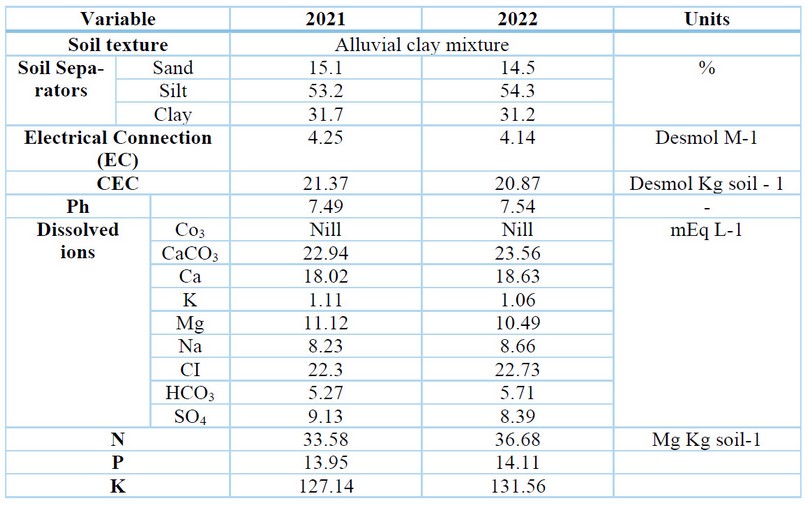
Table 1. Some chemical and physical properties of field soil for the years 2021- 2022
Studied traits
1- Panicle weight (g)
2- Number of grains per panicle
3-100-grains weight (g)
4-Crop growth rate for the period from 100% inflorescence to the physiological maturity (gm-2.day-1) (CGR)
5-Grain yield (tons.ha-1).
RESULTS AND DISCUSSION
Panicle weight
Results in tables (2) and (3) show a significant difference between the varieties in the panicle weight. The variety Inqath (V2) produced the highest trait average, amounting to 164.54 and 162.78g, compared to Lilo (V3), achieving the lowest panicle weight averaging 127.13 and 116.58g for the two study seasons, respectively. The difference between the varieties in panicle weight may be due to their difference in the number of grains in the panicle (Tables 2 and 3), which is consistent with the findings of Al-Kubaisi and Najm 15, 5, who indicated that sorghum varieties differed significantly in panicle weight.
Results listed in Tables (2) and (3) illustrate a significant difference in the panicle weight due to the effect of the nano-fertilizer spraying treatments. Spraying nano-iron (N1) achieved the highest character average, amounting to 154.79 and 153.40g, compared to the control treatment (N0), reaching the lowest panicle weight averages of 134.27 and 125.84 for the two study seasons, respectively.
The binary interaction between the varieties and the nano-fertilizer spraying was significant in Tables (2) and (3) and the panicle weight. The plants of the variety Inqath (V2) sprayed with nano-iron (N1) achieved the highest value of the interaction, which was 173.22 and 173.61g for the two seasons, respectively, which did not differ significantly from the plants of the same variety sprayed with nano-zinc (N2) in the second seasons which achieved 169.63g. While the plants of the Lilo variety (V3) sprayed with distilled water only (N0) achieved the lowest interaction value of 118.48 and 104.48g for the two seasons, respectively.
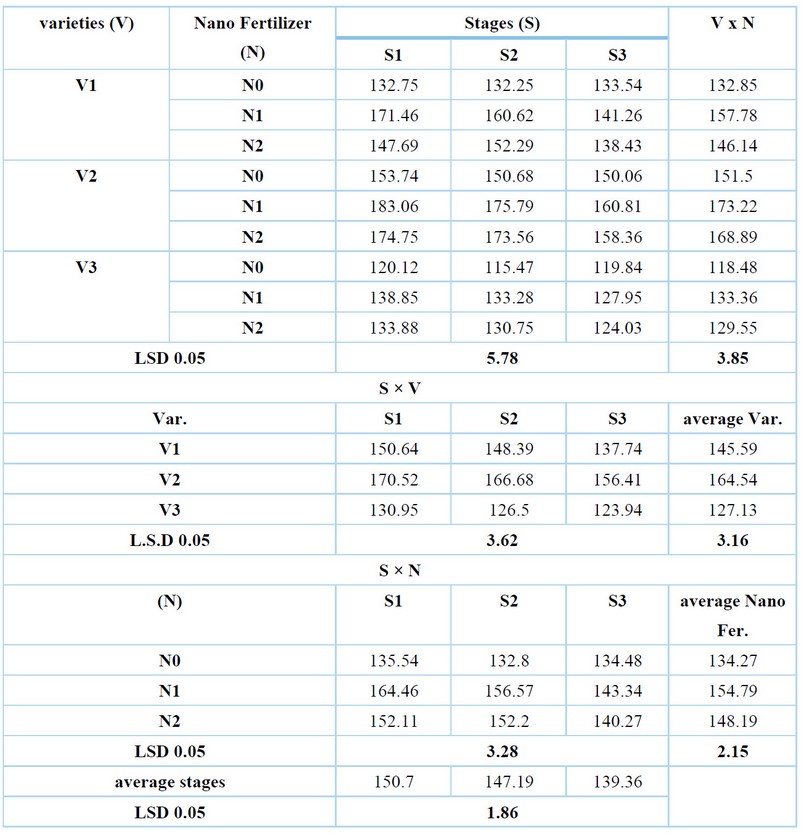
Table 2. Shows the effect of spraying nano fertilizers and the y stage on the Panicle weight of Sorghum varieties (The first season).
The interaction between the varieties and the stages of spraying the nano-fertilizers affected the panicle weight significantly in Tables (2) and (3). The plants of the variety Inqath (V2) spread at the stage of the emergence of five true leaves (S1) gave the highest interaction values wof170.52 and 171. On the contrary, plants of the variety Lilo (V3) sprayed at the stage of 50% of inflorescence (S3) reached the lowest values of the interaction, which were 123.94 and 110.43g for the two seasons of the study. Those did not differ significantly from plants of the same variety (V3) sprayed at the stage of the last folded leaf (S2) emergence, giving 126.50g in the first season of the study.
Concerning the binary interaction between the spraying of nano-fertilizers and the spray stages, the effect on the head weight was significant in Tables (2) and (3), as the nano-iron (N1) spraying at the location of the emergence of five true leaves (S1) attained the highest value of the interaction, amounted to 164.46 and 165. In contrast, the control treatment (N0) at the three stages (S1, S2, and S3) achieved the lowest values of the interaction, which were 135.54, 132.80 and 134.48g in the first season and 127.22, 125.99 and 124.30g in the second season at the three stages respectively without significant difference between them.
The triple interaction between the study factors was significant in the panicle weight in Tables (2) and (3). The plants of the variety Inqath (V2) sprayed with nano-iron (N1) at the stage of the emergence of five true leaves (S1) gave the highest values of the interaction, which were 183.06 and 186.32g for the two study seasons. They did not differ significantly from the plants of the same variety sprayed with nano-zinc at the emergence stage of five true leaves (V2N2S1) that gave 179.68g in the second season. While the plants of the variety Lilo (V3) sprayed with distilled water only (N0) gave, at the three stages (S1, S2, and S3), the lowest values of the interaction reached 120.12, 115.47, and 119.84g in the first season and 105.70, 106.84 and 100.89g in the second season and for the three stages respectively without significant difference between them.
The results above show the positive role of spraying nano iron at the stage of the emergence of five true leaves in increasing the percentage of fertilized florets and then increasing the number of grains in the panicle, which led to an increase in the weight of the panicle.
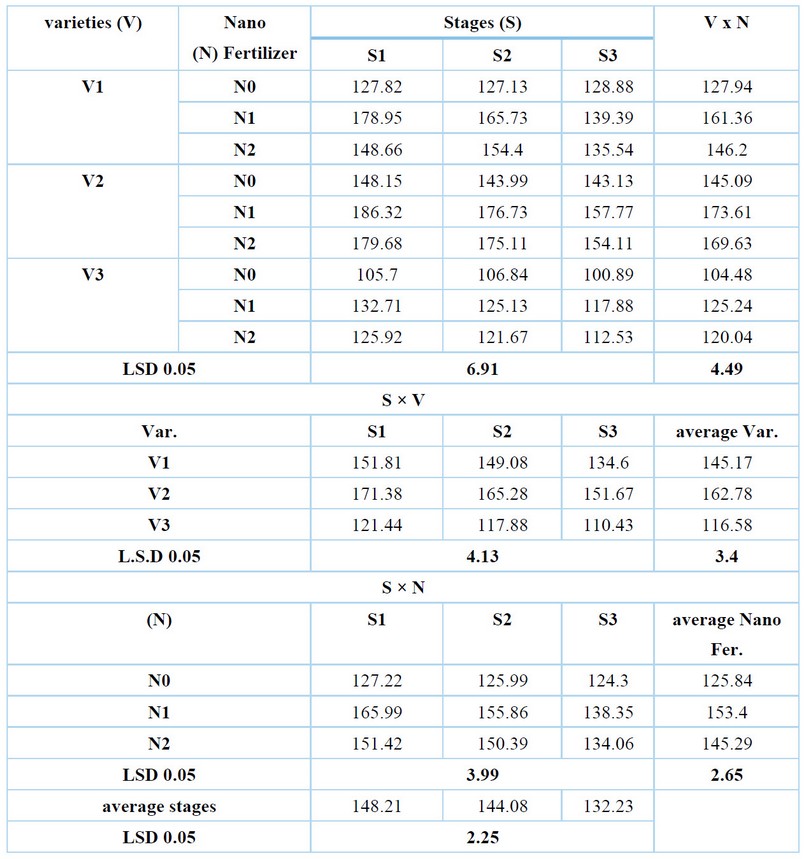
Table 3. Shows the effect of spraying Nano fertilizers at the spray stage on the Panicle weight of varieties of Sorghum (The second season)
Number of grains per panicle
Results in tables (4) and (5) show a significant difference between the sorghum varieties in the number of grains per panicle. Variety Inqath (V2) attained the highest average of 2681.9 and 26849.8 grains. panicle-1. The difference may be due to the genetic nature. This result is consistent with those found by 4 and 18.
Spraying nano-iron (N1) was significantly superior and attained the highest average number of grains per panicle, which amounted to 2524.9 and 2471.2 grains. panicle-1, compared to the control treatment (N0), achieved the lowest average for the trait of 21111.3 and 2121.9 grains.head-1 for the two study seasons, respectively. The superiority of nano-iron spraying may be due to an increase in the products of photosynthesis, their transmission and accumulation in the reproductive parts, and the reduction of competition between them. This increases the percentage increase in the level of necessary elements that help in the success of pollination and double fertilization. Then, the growth of the number of grains in the panicle is in line with the results obtained by 12 in his study on wheat. That indicated a significant effect of nano iron spraying on the number of grains in the ear.
The results in Tables (4) and (5) show that nano fertilizer spraying at the five true leaf emergence stages (S1) was significantly higher than the highest average number of grains per panicle, which amounted to 2465, 3 and 2414.6 grains panicle-1, compared to spraying at the 50% flowering stage (S3), which reached the lowest mean for the trait, amounting to 2189.2 and 2191.5 grains panicle-1 for the two study seasons, respectively.
The number of grains per panicle is affected by several factors, including the availability of nutrients at the appropriate stage of plant growth. So the superiority of plants sprayed at the growth stage of five actual leaf emergence may be due to the essential role of feeding these elements at the early stages of plant growth in stimulating vegetative growth.
The effect of binary interaction between varieties and nano fertilizer spraying was significant on the number of grains per panicle in tables (4) and (5). The plants of the variety Inqath (V2) sprayed with nano-iron (N1) achieved the highest interaction value of 2846.0 and 2788.3 grains of panicle-1, respectively; however, they did not differ significantly from the plants of the same variety (V2) sprayed with nano-zinc (N2) which gave 2788.9 and 2739.5 grains.panicle-1.
While Lilo plants sprayed with distilled water only (N0) achieved the lowest interaction value of 1814.4 and 1859.7 panicle-1 for two seasons, respectively.
As for the binary interaction between the varieties and the stages of spraying the nano-fertilizers, it had a significant effect on the number of grains per panicle Tables (4) and (5), as the plants of the variety Inqath (V2) sprayed at the stage of the emergence of five true leaves (S1) gave the highest value of the interaction, which was 2813.1 and 2767.1 grain. panicle-1, while the plants of the variety Lilo (V3) sprayed at (S3) achieved the lowest value of the interaction, which was 1902.2 and 1932.3 grains.panicle-1 for the two seasons, respectively.
Concerning the binary interaction between spraying nano-fertilizers and the spray stages, it had a significant effect on the number of grains per panicle Tables (4) and (5), as the spraying of nano-iron (N1) at the stage of the emergence of five true leaves (S1) achieved the highest value of the interaction, which amounted to 2727.7 and 2644.3 grains. panicle-1, while the control treatment (N0) at the three stages (S1, S2, and S3) achieved the lowest value of the interaction, which in the first season was 2148.2, 2113.5, and 2072.3 grains.panicle-1, and in the second season 2147.9, 2110.3 and 2107.6 grains. panicle-1 for the three stages, respectively and without significant difference between them.
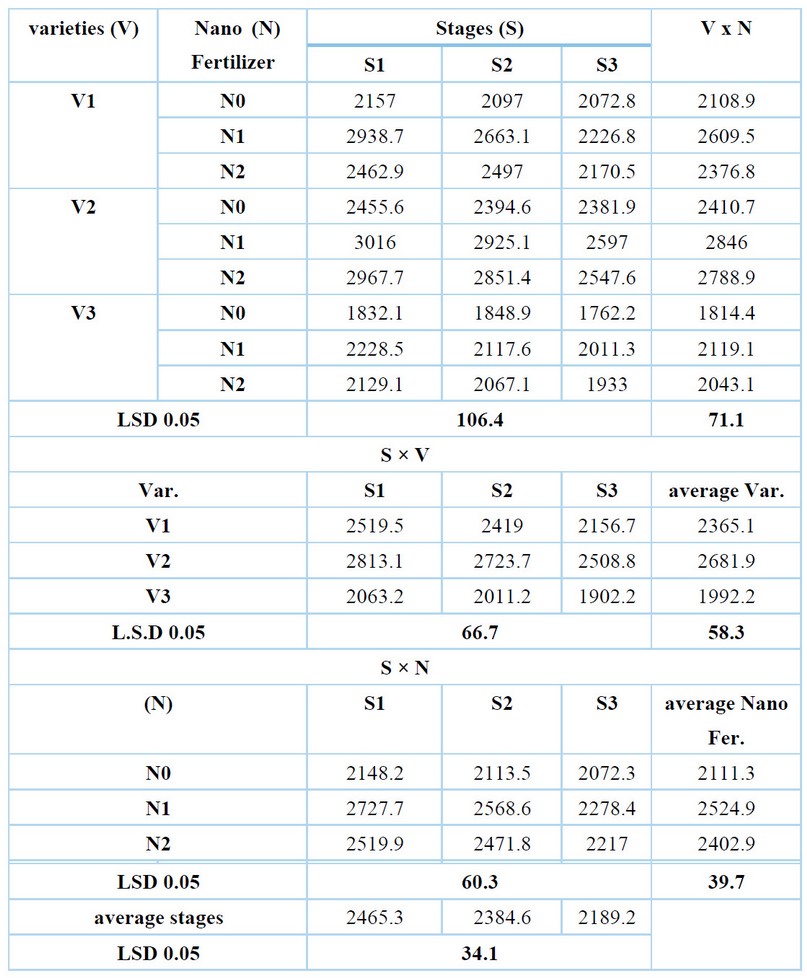
Table 4. Shows the effect of spraying nano fertilizers and spray stage on the number of grains per panicle of varieties of Sorghum (The first season)
The effect of the triple interaction between the study factors was significant in the number of grains per panicle in Tables (4) and (5), the plants of the variety Inqath (V2) that were sprayed with nano-iron (N1) at the stage of the emergence of five true leaves (S1) gave the highest value of the interaction which was 3016.0 and 2962.7 grains.panicle-1.
It did not differ significantly from plants of the same variety sprayed with nano-zinc at the stage of the emergence of five true leaves (V2N2S1), which gave 2967.7 and 2878.5 grains.panicle-1, and the plants of the same variety sprayed with nano-iron at the stage of the emergence of the last folded leaf (V2N1S2) in the first season. While plants of variety Lilo (V3) sprayed with distilled water only (N0) in the three stages (S1, S2, and S3) achieved the lowest interaction value of 1832.1, 1848.9, and 1762.2 grains. panicle-1 in the first season, 11.62, 11.72 and 11.17 grains.panicle-1 in the second season for the three stages, respectively, without significant difference between them.
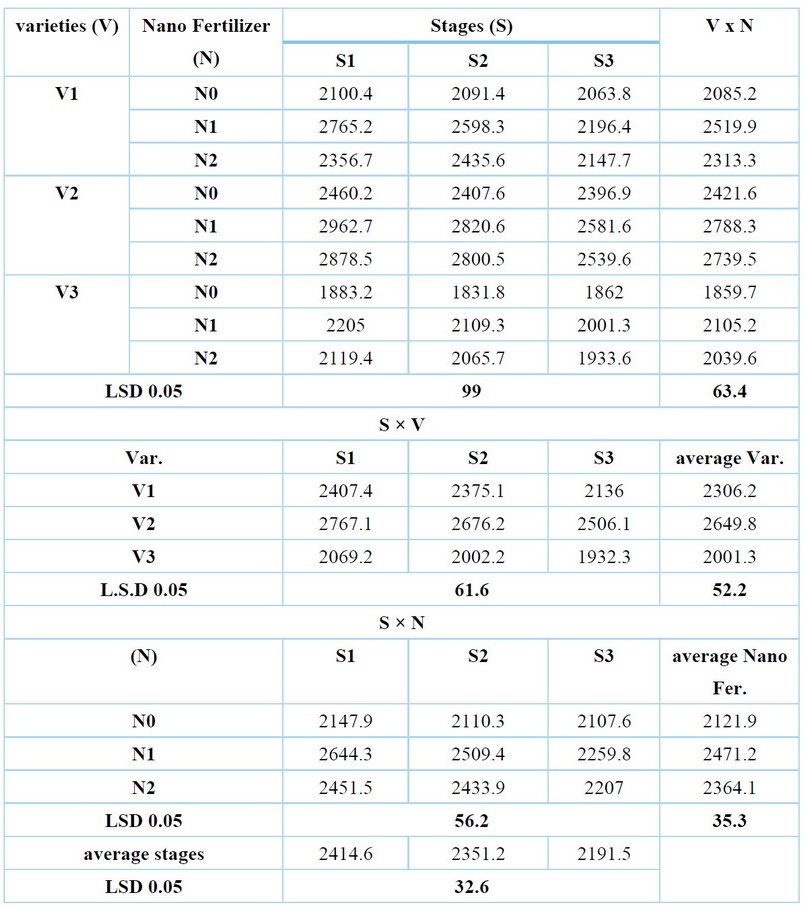
Table 5. Shows the effect of spraying Nano fertilizers and spray stage Number of grains per panicle of varieties of Sorghum (The second season)
1000-grain weight
Results in the two tables (6) and (7) show significant differences between the sorghum varieties in 1000-grain weight. The variety Rabih (V1) gave the highest average of this trait, amounting to 27.96 and 30.89g, which did not differ significantly from the variety Inqath giving 27.63 and 30.32g. Variety Lilo (V3) produced the lowest 1000-grain weight averaging 24.50 and 24.17g in the two seasons. The difference between the sorghum varieties in the 1000-grain weight is due to the difference in the genetics of each variety's nature. This result agrees with the findings of Al-Maini and Shammari 6, 18.
Spraying nano-zinc (N2) was significantly superior in 1000-grain weight achieving the highest weight amounted to 28.62 and 30.86g, compared to the control treatment (N0), which produced the lowest average for the trait of 24.17 and 25.65g for the two study seasons Tables (6) and (7). The superiority of spraying nano-Zn in grain weight may be due to the physiological effect of zinc on the formation of amino acids and carbohydrates (7). This result agrees with the findings (17) about Sorghum, indicating a significant increase in Grain weight when spraying with nano-zinc.
The results of Tables (6) and (7) show that spraying nano-fertilizers in the stage of the emergence of the last folded leaf (S2) was significantly superior in 1000-grain weight giving the highest value of which amounted to 27.58 and 29.51g, compared to spraying it at the stage of (S3), which achieved the lowest average of 25.63 and 27.14g for the two study seasons respectively. This shows that spraying nano-micronutrients at the stage of the emergence of the last folded leaf (S2) was the most effective in transferring the photosynthetic products to the fertilized florets.
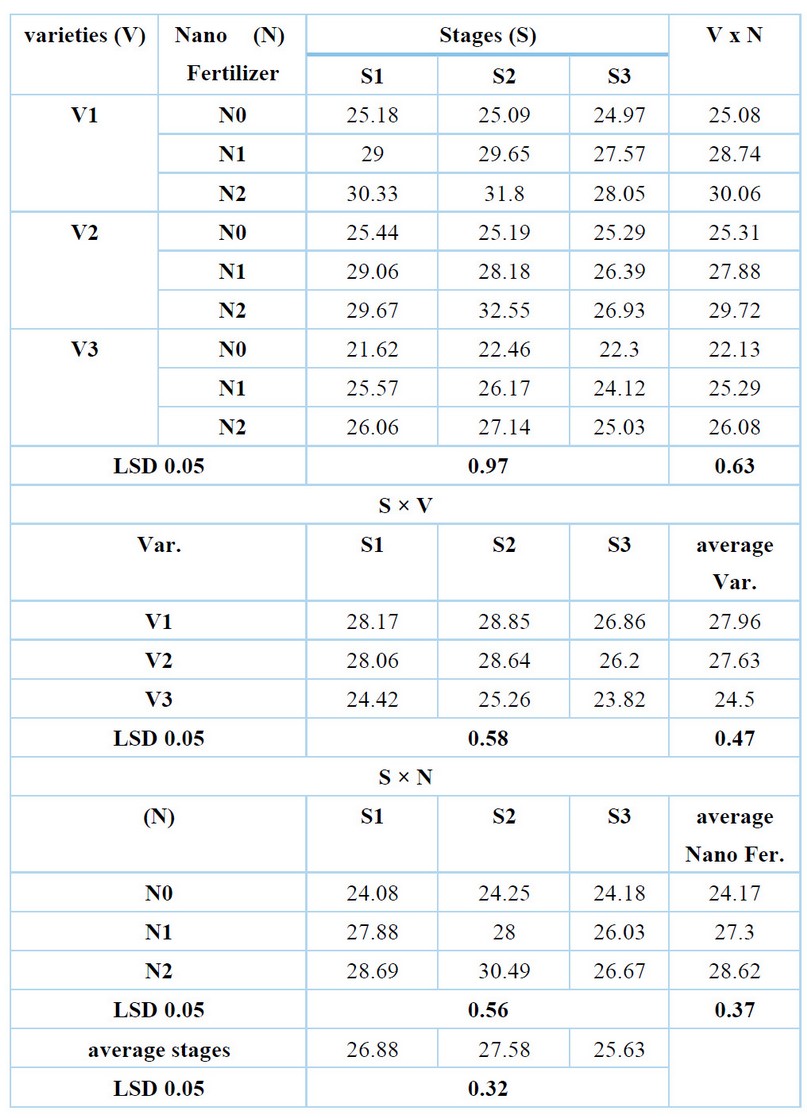
Table 6. Shows the effect of spraying nano fertilizers and the spray stage on the 1000-grain weight of Sorghum varieties (The first season).
The effect of the binary interaction between the varieties and spraying the nano-fertilizer was significant in the 1000-grain weight Tables (6) and (7). The Rabeh variety plants (V1) spread with nano-zinc (N2) achieved the highest interaction values of 30.06 and 33.62g. They did not differ significantly from the plants of the variety Inqath (V2) sprayed with nano-zinc (N2), which gave 29.72 and 33.50g, while plants of the variety Lilo (V1) sprayed with distilled water only (N0) achieved the lowest interaction values of 22.13 and 22.39g for the two seasons respectively.
The binary interaction between the varieties and the stages of spraying nano-fertilizers affected the 1000-grains weight significantly in Tables (6) and (7). The variety Rabeh's plants (V1) spread at the stage of the emergence of the last folded leaf (S2) gave the highest value of the interaction, which was 28.85 and 32.20g for the two seasons of the study, respectively. They did not differ significantly from the plants of the variety Inqath (V2) sprayed in the stage of the emergence of the last folded leaf (S2) that gave 28.64 gm in the first season. While the plants of the variety Lilo (V3) sprayed at the stage of the emergence of the last folded leaf (S2) achieved 50% inflorescence (S3) and had the lowest interaction values reaching 23.82 and 23.51g for the two seasons, respectively. It did not differ significantly from the plants of the same variety sprayed at the emergence stage of five true leaves (S1), which achieved 24.04 g in the second season.
The binary interaction between spraying nano-fertilizers and the spray stages significantly affected the 1000-grain weight Tables (6) and (7). Spraying nano-zinc (N2) at the location of the appearance of the last folded leaf (S2) gave the highest values of the interaction, which were 30.49 and 32.88g. While the control treatment (N0) at the three stages (S1, S2, and S3) gave the lowest interaction values, which in the first season were 24.08, 24.25, and 24.18g, and in the second season were 25.34, 25.91, and 25.69g for the three stages respectively without significant difference between them.
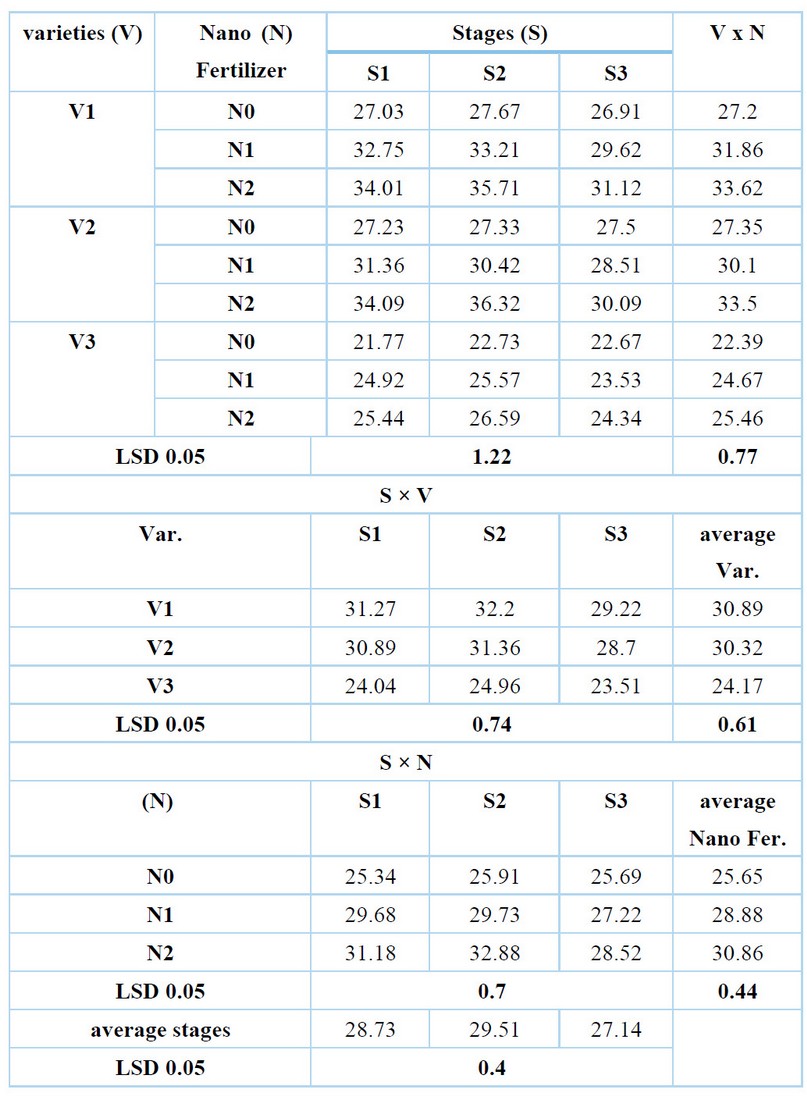
Table 7. Shows the effect of spraying nano fertilizers and spray stage on 1000-grain weight of varieties of Sorghum (The second season)
The effect of the triple interaction between the study factors was significant in the 1000-grain weight Tables (6) and (7). The plants of the variety Inqath (V2) sprayed with nano-zinc (N1) at the stage of the emergence of the last folded leaf (S2) gave the highest values of the interaction, which were 32.55 and 36 for the two seasons of the study respectively, which did not differ significantly from the plants of the variety Rabah sprayed with nano-zinc at the stage of the emergence of the last folded leaf (V1N2S2), which gave 31.80g in the first season. While the plants of the variety Lilo (V3) that were sprayed with distilled water only achieved (N0) at the three stages (S1, S2, and S3), the lowest interaction value were 21.62, 22.46, and 22.30g in the first season and 21.77, 22.73 and 22.67g in the second season at the three stages respectively without significant difference between them.
Crop growth rate for the period from 100% inflorescence to physiological maturity (g.m-2.day-1)
The results of tables (8) and (9) show a significant difference between sorghum varieties in the crop growth rate. The variety Inqath (V2) gave the highest average for the trait of 15.79 and 16.93g.m- 2.day-1 compared to the variety Rabeh (V1), which achieved the lowest standard of 11.94 and 12.63g.m- 2.day-1 for the two study seasons, respectively. This result is consistent with the findings of (1) and (4), indicating that sorghum varieties differed significantly in the growth rate of their plants.
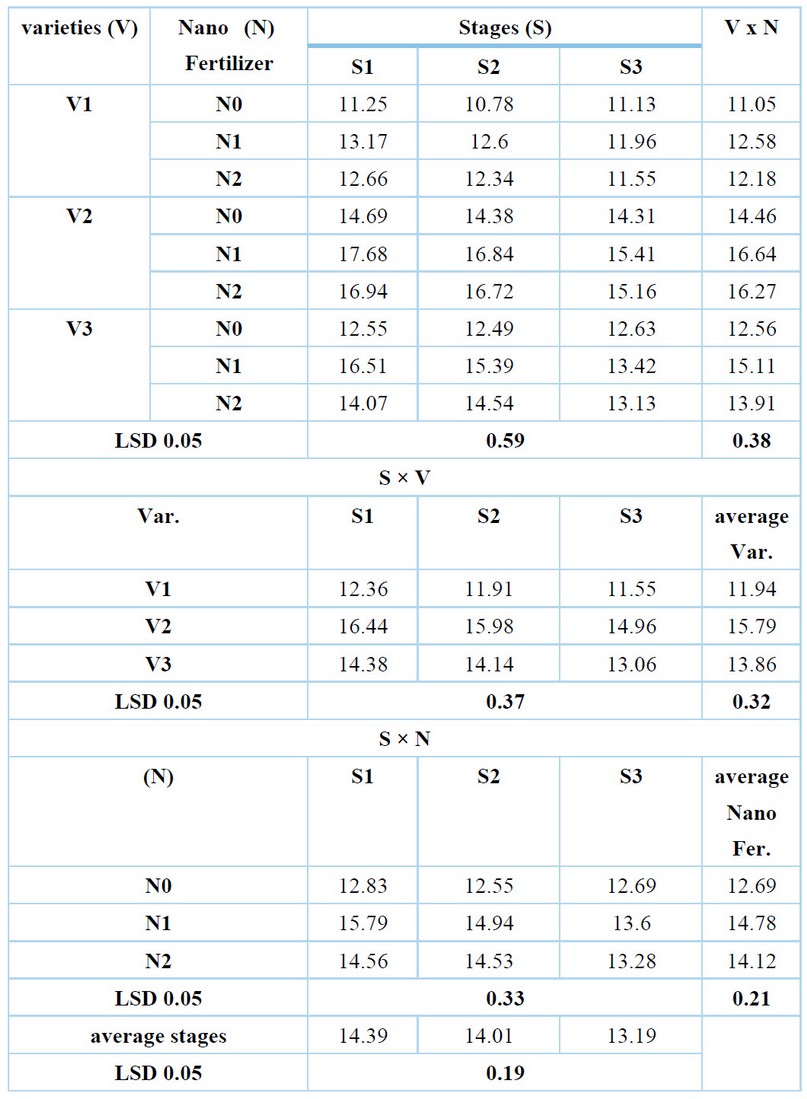
Table 8. Shows the effect of spraying nano fertilizers and spray stage on (CGR) of varieties of Sorghum (The first season)
The results of tables (8) and (9) indicate that spraying nano iron (N1) was significantly superior and achieved the highest growth rate of the crop, which reached 14.78 and 16.08g.m- 2.day-1, compared to the control treatment (N0), which attained the lowest average of 12.69 and 13.49g.m- 2.day-1 for the two study seasons, respectively.
The results of Tables (8) and (9) show that spraying nano-fertilizers at the stage of the emergence of five true leaves (S1) was significantly superior. It attained the highest crop growth rate reaching 14.39 and 15.60g.m- 2.day-1 compared to spraying it at the stage of 50% inflorescence (S3), which achieved the lowest average, reaching 13.19 and 14.09g.m-2.day-1 for the two study seasons, respectively, showing that the role of spraying micronutrients at the early stages of plant growth in stimulating vegetative growth and increasing the plant growth rate for the period from 100% inflorescence until physiological maturity.
The effect of the binary interaction between the varieties and spraying nano-fertilizer was significant on the growth rate of the crop Tables (8) and (9). The plants of the variety Inqath (V2) sprayed with nano-iron (N1) achieved the highest interaction values of 16.64 and 17.94g.m-2.day-1, which did not differ significantly from the plants of the same variety that were sprayed with nano-zinc (N2) which gave 16.27 and 17.58 g.m-2.day-1. While the plants of the variety Rabih (V1) sprayed with distilled water only (N0) achieved the lowest interaction values of 11.05 and 11. 50 g.m-2.day-1 for the two study seasons, respectively.
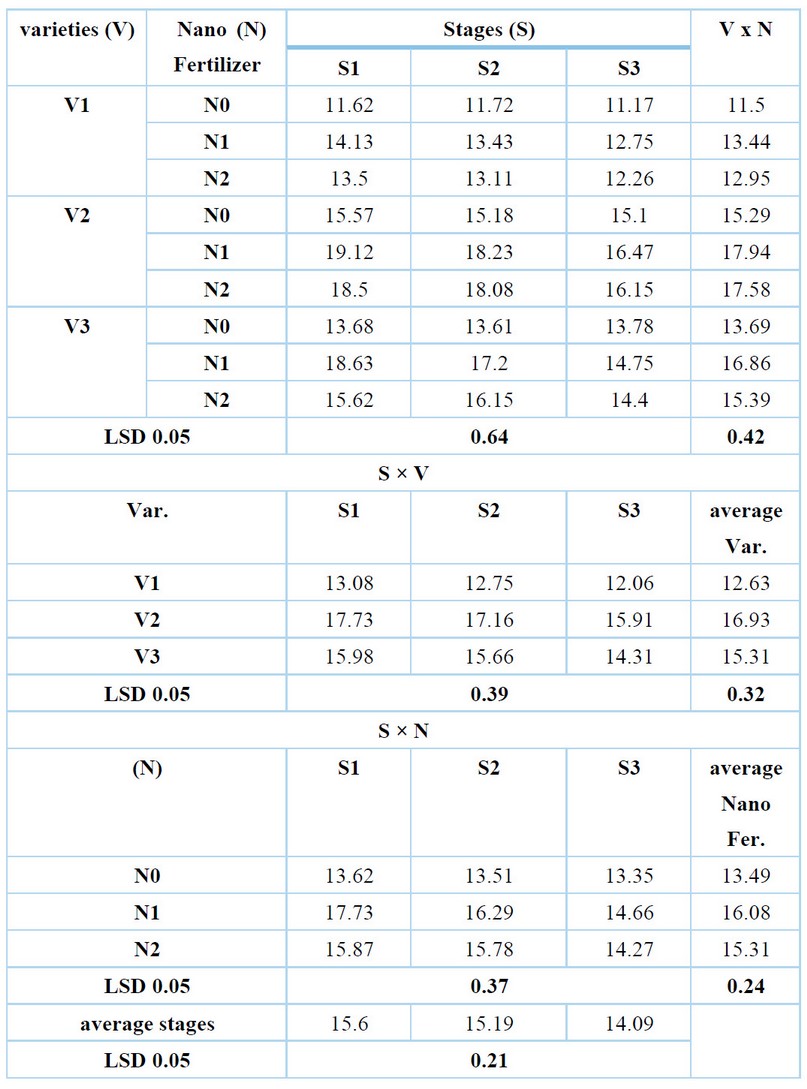
Table 9. Shows the effect of spraying nano fertilizers and spray stage on (CGR) of varieties of Sorghum (The second season)
For the binary interaction between the varieties and the stages of spraying nano-fertilizers, it had a significant effect on the growth rate of the crop Tables (8) and (9). The plants of the variety Inqath (V2) that were sprayed at the stage of the emergence of five true leaves (S1) gave the highest interaction values, which were 16.44 and 17.73 g.m-2.day-1, while the plants of the variety Rabih (V1) sprayed at 50% inflorescence stage (S3) achieved the lowest interaction values of 11.55 and 12.06 g.m-2.day-1 for the two study seasons, respectively.
Concerning the binary interaction between the spraying nano-fertilizers and the spraying stages, it affected the growth rate of the crop significantly Tables (8) and (9). Spraying nano-iron (N1) at the stage of the emergence of five true leaves (S1) achieved the highest interaction values, which were 15.79 and 17.73 g.m-2.day-1, while the control treatment (N0) at the three stages (S1, S2, and S3) achieved the lowest values of the interaction, reaching in the first season 12.83, 12.55, and 12.69 g.m-2.day-1 and 13.62, 13.51, and 13.35 g.m-2.day-1 in the second season for the three stages, respectively, without significant difference between them.
The effect of the triple interaction between the study factors was significant on the growth rate of the crop Tables (8) and (9). The plants of the variety Inqath (V2) sprayed with nano-iron (N1) at the stage of the emergence of five true leaves (S1) gave the highest values of the interaction, which were 17.68 and 19.12 g.m-2.day-1. The plants of the same variety sprayed with nano-zinc in the stage of the emergence of five true leaves (V2N2S1) were not significantly different for the two study seasons, which gave 18.50 g.m-2.day-1 in the second season. While the plants of the variety Rabih (V1) were sprayed with water, only distilled water (N0) in the three stages (S1, S2, and S3) achieved the lowest interaction values of 11.25, 10.78, and 11.13g.m-2.day-1 in the first season and 11.62, 11.72, and 11.17 g.m-2.day-1in the second season for the three stages respectively without any significant difference between them.
Grain yield (t.ha-1)
It is noticed from the results of tables(10) and that there is a significant difference between sorghum varieties in grain yield. The variety Inqath (V2) achieved the highest average for the trait amounting to 5.344 and 5.079 tons.ha-1 compared to the variety Lilo (V1), which attained the lowest grain yield average of 3.943 and 3 .588 tons.ha-1 for the two study seasons, respectively.
The reason for the superiority of the variety Inqath in grain yield may be due to its prominence in panicle weight Tables (2) and (3), the number of grains per panicle Tables (4) and (5), and the crop growth rate for the period from 100% inflorescence to physiological maturity Tables (8) and (9). These results are consistent with the findings of (4) and (18), who indicated that sorghum varieties differed significantly in grain yield.
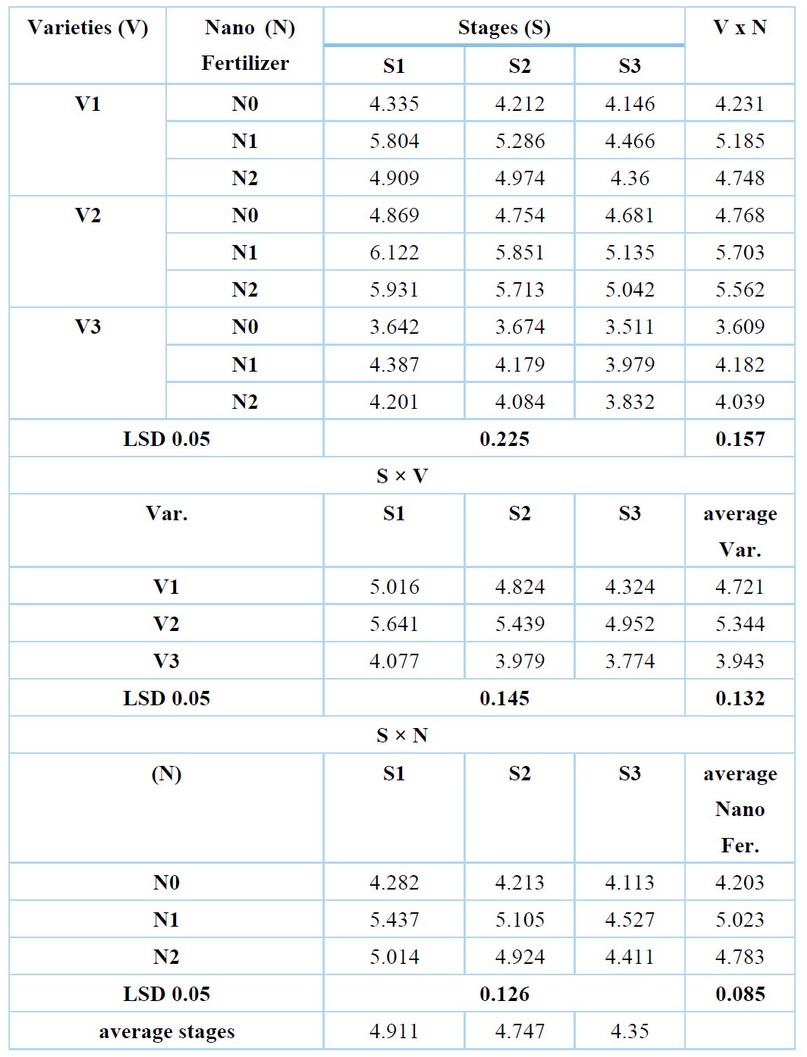
Table 10. Shows the effect of spraying nano fertilizers and spray stage on Grain yield (t.ha-1)of varieties of Sorghum (The first season)
Spraying nano-iron (N1) was significantly superior. It achieved the highest average grain yield of 5.023 and 4.828 tons.ha-1 compared to the control treatment (N0), which attained the lowest average of 4.203 and 3.872 tons.ha-1 for the two study seasons, respectively Tables (10) and (11). The reason behind the superiority of spraying nano-iron in the grain yield may be due to its dominance in panicle weight Tables (2) and (3), the number of grains per panicle Tables (4) and(5), and the growth rate of the crop for the period from 100% inflorescence to physiological maturity Tables (8) and (9). In the same direction, the results of (16) and (9) in maize yield showed a significant increase in grain yield due to spraying nano iron.
The results of the two tables (10) and (11) show that spraying nano-fertilizers in the stage of the emergence of five true leaves (S1) was significantly superior to the highest grain yield average of 4.911 and 4.655 tons.ha-1 compared to spraying it in the stage of 50% inflorescence (S3), which produced the lowest yield average of 4.350 and 4.081 tons.ha-1 for the two study seasons sequentially.
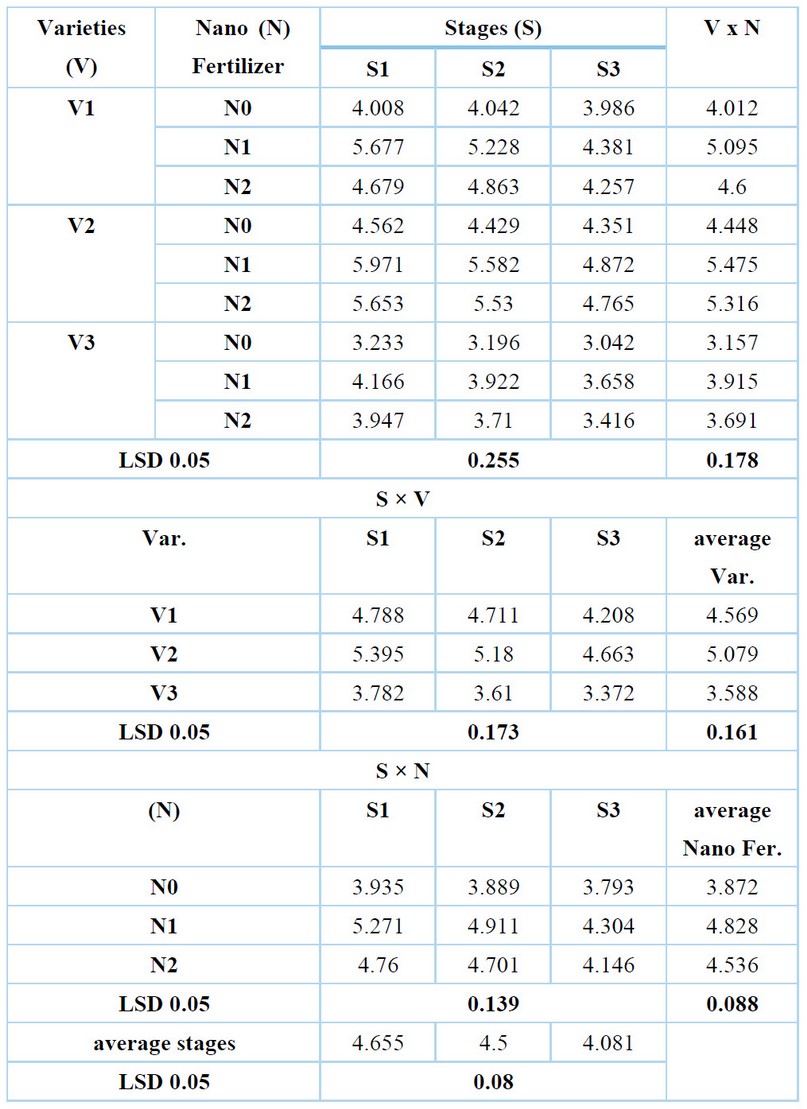
Table 11. Shows the effect of spraying nano fertilizers and spray stage on Grain yield (t.ha-1)of varieties of Sorghum (The second season)
The effect of the binary interaction between the varieties and the nano-fertilizer spraying was significant on the grain yield in Tables (10) and (11). The plants of the variety Inqath (V2) sprayed with nano-iron (N1) achieved the highest values of the interaction, which were 5.703 and 5.475 grains of tons.ha-1, and it did not differ significantly from the plants of the same variety that were sprayed with nano-zinc (N2) achieving 5.562 and 5.316 tons.ha-1. The plants of the variety Lilo (V3) sprayed with distilled water only (N0) achieved the lowest interaction values of 3.609 and 3.157 tons.ha-1 for the two study seasons, respectively
The binary interaction between the varieties and the stages of spraying the nano-fertilizers affected the grain yield significantly in Tables (10) and (11). The plants of the variety Inqath (V2), sprayed nano fertilizer at the stage of the emergence of five true leaves (S1), gave the highest interaction values, which were 5.641 and 5.395 tons.ha-1, while the plants of the variety Lilo (V3) sprayed at the 50% inflorescence stage (S3) gave the lowest interaction values, which were 3.774 and 3.372 tons.ha-1, for the two seasons, respectively.
As for the binary interaction between the spraying of nano-fertilizers and the stages of spraying, it significantly affected the grain yield in Tables (10) and (11). Spraying nano-iron (N1) at the stage of the emergence of five true leaves (S1) achieved the highest value of the interaction, amounting to 5.437 and 5.271 tons.ha-1, while the control treatment (N0) at the three stages (S1, S2, and S3) achieved the lowest value of the interaction that in the first season were 4.282, 4.213, and 4.113 tons.ha-1 and in the second season were 3.935, 3.889 and 3.793 tons.ha-1 for the three stages respectively without significant difference between them.
The triple effect of the interaction between the study factors was significant in the grain yield Tables (10) and (11). The plants of the variety Inath (V2) sprayed with nano-iron (N1) at the stage of the emergence of five true leaves (S1) gave the highest values of the interaction, which were 6.122 and 5.971 tons.h-1 for the two study seasons respectively. Yet, they did not differ significantly from the plants of the same variety sprayed with nano-zinc in the emergence stage of five true leaves (V2N2S1), which gave 5.931 tons.ha-1 in the first season. In contrast, the plants of the variety Lilo (V3) sprayed with distilled water only (N0) achieved in the three stages (S1, S2, and S3), the lowest interaction values were 3.642, 3.674 and 3.511 tons.ha-1 in the first season and 3.233, 3.196 and 3.042 tons.ha-1 in the second season at the three stages respectively without any significant difference between them.
It appears from the results of the triple interaction that the variety Inqath, sprayed with nano iron at the stage of the emergence of five true leaves, invested its genetic energy and physiological efficiency and directed them towards increasing panicle weight and the number of grains in the panicle and the (Tables 2, 3, 4 and 5), positively reflected on its superiority in grain yield, which is the outcome of the biological processes that take place within the plant system. It is also apparent that the grain yield of the three sorghum varieties was more responsive to spraying nano iron at the emergence stage of five real leaves. Still, the size of the response was different according to the difference in the genetic material of each variety and its response to environmental conditions, which explains the reason for the significant effect of the interaction between the study factors.
CONCLUSIONS
Nano-fertilizers are of economic benefit because the quantities used are minimal compared to conventional fertilizers, as well as with a high and quick response by the plant due to the small size of their particles; through the study, it was found that fertilizer iron and nano-zinc has a positive effect on yield traits, as well as cultivars differed significantly among themselves in yield traits and cultivar superiority (V3) Also, the spraying stages differed considerably among themselves. The stage (S1) was significantly superior compared to the other stages.
REFERENCES
1. Abdulhameed, Z. A. J.,. Estimation of genetic parameters of several sorghum genotypes under plant density. Anbar Journal of Agricultural Sciences. 2016, 14 (1).
2. AL-Baldawi ,M.H.K. and J.H.Hamza. .Seed priming effect on field emergence and grain yield in Sorghum, 2017 .18(2):404-423.
3. Al-Dulaimi, H. N. and A. J. Al-Daraji.,. Effect of different concentrations of iron and zinc on the nutritional content of wheat plants Triticum aestivum L. Al-Furat Journal of Agricultural Sciences, 2014, 6(1): 200-207.
4. Al-Fahdawi, M. A. S.. Effect of potassium spray on growth and grain yield and its components for three sorghum varieties. Master's thesis, Department of Field Crops, 2018, College of Agriculture, University of Anbar.
5. Al-Kubaisi, M. I. H. and M. A. Abed and S. I. Abdullah. Effect of spring and autumn sowing dates on yield and components of sorghum varieties. Anbar Journal of Agricultural Sciences. 15 (special issue of the conference): 2017, 166-178.
6. Al-Maini, W. K. A. M. and Y. J. A. Al-Issawi.,. Effect of foliar feeding with bread yeast extract (Sacchharomyces cerevisiae) on grain yield and components of five sorghum varieties of Sorghum bicolor (L.) moench. Anbar Journal of Agricultural Sciences. 2017, 15(1).
7. Anand, R.; V. Koti; M. Y. Kamatar; U. V. Mumigatti and B. Basavaraj. Evaluation of Rsbi sorghum genotypes for seed zinc content and yield in high zinc regimes. USA Karnataka J. Agric. Sci., 2008, 21(4): 568-569.
8. Dambiwal, D., Katkar, R. N., Kumawat, K. R., Hakla, C. R., Bairwa, B., Kumar, K., and Lakhe, S. R.,. Effect of soil and foliar application of zinc on Sorghum (Sorghum bicolor L. Moench) yield, agronomic efficiency and apparent recovery efficiency. IJCS, 2017, 5 (4) : 435- 438.
9. Eliaspour, Siamak, et al. "Effects of biofertilizers and iron nano‐oxide on maize yield and physiological properties under optimal irrigation and drought stress conditions." Food Science & Nutrition, 2020, vol.8.no.11: 5985-5998.
10. F.A.O,. Food and Agriculture organization of theUnited Nations. Quarterly bulletin statistics., 2018
11. Focus, The importance of micro-nutrients in the region and benefits of including them in fertilizers. Agro-Chemicals Report., 2003, 111(1): 15-22.
12. Ghafari, H. and J. Razmjoo.,. Effect of foliar application of nano iron oxide, iron chelate and iron sulphate rates on yield and quality of wheat. International Journal of Agronomy and Plant Production., 2013, 4(11): 2997-3003.
13. Havlin, J. L.; D. Beaton; S. L. Tisdale and W. L. Nelson.,. Soil Fertility and Fertilizer. 7th Edn. An Introduction to Nutrient Management. New Jersey. USA, 2005. p. 223-354.
14. Nair, R.; S. H. Varghese; B. G. Nair; T. Maekawa; Y. Yoshida and D. S. Kumar,. Nanoparticle material delivery to plants. Plant Sci., . 2010, 179: 154-163.
15. Najm, R. R., Effect of seed stimulation on germination and emergence of seedlings, growth and yield of sorghum grains. Master Thesis, Department of Field Crops, College of Agriculture, University of Baghdad., 2016, p. s. 90.
16. Pariona, N., et al. "Magnetic and structural properties of ferrihydrite/hematite nanocomposites." Journal of Magnetism and Magnetic Materials, 2016, 406: 221-227
17. Poornima, R. and R. V. Koti. Effect of nano zinc oxide on growth, yield and grain zinc content of Sorghum (Sorghum bicolor). J. Pharmacognosy and Phytochem., 2019, 8(4): 727-731.
18. Shammari, A. H. A. M.. ,Growth response and yield of sorghum Sorghum bicolor (L.) Moench varieties, foliar fertilized with nano zinc and copper. Master thesis, College of Agriculture, 2019, University of Basra. p. s. 61.
19. Vanderlip, R. L. and H. E. Reeves., Growth Stages of Sorghum [Sorghum bicolor (L.) Moench]. Agron. J., 1973, vol. 64,no.1: 13-16.
Received: August 25, 2022 / Accepted: October 12, 2022 / Published:15 November 2022
Citation: Al-Rubaie M A J, Mohammed A R, Ali H S. Nano fertilizer spraying affects the yield of Sorghum (Sorghum bicolor L.) varieties. Revis Bionatura 2022;7(4) 32. http://dx.doi.org/10.21931/RB/2022.07.04.32
